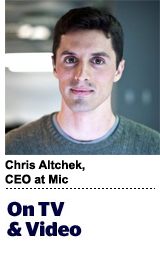 “On TV And Video” is a column exploring opportunities and challenges in programmatic TV and video.
“On TV And Video” is a column exploring opportunities and challenges in programmatic TV and video.
Today’s column is written by Chris Altchek, CEO at Mic.
Digital video consumption habits have rapidly evolved over the last five years. Viewers have transitioned from spending 100% of their time on traditional cable to consuming content on mobile and digital platforms.
Television is not going away, though, and the $69 billion ad industry that supports it remains a formidable force. But the way content is being produced and consumed is changing.
Americans used to spend 5.5 hours per day watching cable TV, but that number is decreasing as platforms begin to prevail as the dominant medium for consuming and distributing content. TV programming that largely fit into wheels of one-size-fits-all 30- and 60-minute blocks is being replaced with vastly different formats.
On one side, people are consuming short-form video on their phones, many times a day. On the other, people are streaming mid- and long-form video through connected TVs, laptops and tablets.
Though the landscape is more complicated when it comes to digital video, unlike cable, there is no one-size-fits-all. These two growing trends will dominate the immediate future and continue to divert eyeballs away from content delivered by your cable set-top box. And the $69 billion ad industry? It will likely soon evolve and follow those eyes.
Short-Form Social Video On Mobile
In terms of distribution, as mobile phone screen sizes have increased and wireless networks have gotten faster, video consumption on phones has increased exponentially. The vast majority of mobile video consumption growth has happened across several social networks, including Facebook/Instagram, Snapchat and Twitter/Vine. As these services have pushed video, time spent and engagement rates are skyrocketing. Distribution is proving to be primarily tied to the platforms with huge numbers of daily engaged users.
The content that works on these networks is short. It’s up to six seconds on Vine and 15 seconds in Instagram, and, although there’s no limit, 90 seconds is the general cut-off on Facebook, with the majority of mobile sessions between 15 seconds and two minutes – short enough to watch while waiting for the bus or taking a quick break from work. The content that performs best is heavily optimized for social sharing and designed to create emotion and inspire human connection. The content producers that are succeeding in this are companies such as NowThis News and AJ+.
For the platforms, the business models are clear: Own the technology platform and user network, promote free content that is user-generated or professionally created for free and sell advertising directly to brands. Short-form video advertising is still new and uncomfortable for brands that are used to 30-second TV spots.
For media companies, the business models are far from clear. The distribution is huge but unpredictable and it’s hard to sell traditional advertising into social channels. Therefore many are leaning toward creating branded content and distributing it across all their social channels. Others are leaning on revenue shares with YouTube, Facebook, Snapchat and other platforms but margins are much lower.
Mid- To Long-Form Streaming Video
As broadband speeds have increased and TVs are being connected to the Internet through Roku, AppleTV, Chromecast and other devices, users are adopting streaming services such as Netflix, Amazon, Hulu and a variety of OTT offerings.
The vast majority of content on these platforms is accessed through users searching for a specific show, actor or movie. In the streaming world, strong brands and amazing content wins. With an emphasis on premium, users are looking for large content libraries with recognizable brands. Traditional cable TV and film producers are dominating, although new brands that create super high-end premium content are beginning to compete.
For the platforms, the business models are either subscription-driven (Netflix, Amazon) or freemium (Hulu) with TV-style advertising. The platforms pay out licensing fees to content creators in a model that resembles cable operators paying cable networks. We are still very much in the early days of this transition and you should expect to see a lot of business model evolution and competition here.
Think of these two monetization opportunities as a barbell. Marketers focusing on one side of the barbell, either long-form premium or short-form mobile, will succeed. The middle ground, though – the not-too-expensive or not-too-memorable video – is a dangerous place to be. It’s not native to one platform and not premium or engaging enough to resonate with audiences who covet this kind of content. To succeed, companies must pick a side of the barbell or be aggressive and go after both.
However we look at the space, cable’s monopoly on Americans’ attention is under attack from two radically different new consumer habits. Both require different distribution strategies, content and business models. And both, as we’re beginning to see, are upending the way generations before have consumed content. We need to be swift, steady and creative in our 2016 video strategies to see success.
Follow Chris Altchek (@caltchek), Mic (@micnews) and AdExchanger (@adexchanger) on Twitter.












